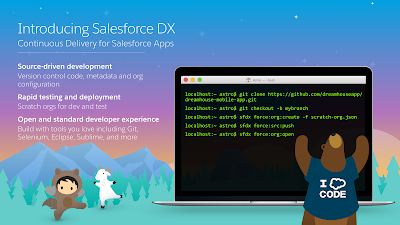Hi All,
This is my first post about SFDX as I planned with you, this is an introductory post as per my understanding, please feel free to contact if you have some correction / updates or any other scenarioes which you want me to cover.
Pre-Requisite is Get Started with Salesforce DX to install the Force.com CLI and related software and some knowledge of GitHub.
What is SFDX [Salesforce Developer Experience]?
A new experience for Developer / Coder to develop application faster and test in a separate organization or individual test environment same as in developer sandbox.
One of the most important changes with Salesforce DX is that, by externalizing more of the metadata and the org shape, we can shift the app’s “source of truth” from the Salesforce org to a version control system. This standard source-driven development approach has been used by developers for years, and it’s now a core part of the Salesforce developer experience.
Another key innovation for Salesforce DX is something we call the scratch org. The scratch org is a brand new org type built specifically for developers and automation. It’s ephemeral, built quickly from your source and metadata, and makes it easy to build your app consistently over and over again, which is great for team collaboration and test automation.
It’s worth noting that scratch orgs aren’t a replacement for sandboxes. Sandboxes are an important part of the larger development lifecycle, and work with our new source-driven development process as the destination for packages built directly from source. All sandbox types, from developer to full, offer the ability to act as user acceptance testing (UAT) and staging environments of the production org.
This following link of Salesforce Blog could get you more idea about SFDX:
This above article from Salesforce has a recorded session and article from Dreamfore 2016, which could be more helpful for you.
Salesforce has provided a powerful tool for learning and for getting started on SFDX, here is the source which will help you to setup and install your machine for SFDX:
Get Started with Salesforce DX
Dev Hub?
A Developer Hub (Dev Hub) provides you and your team with the ability to create and manage scratch orgs. Scratch orgs are temporary Salesforce environments where you do the bulk of your development work in this new source-driven development paradigm.
Scratch Orgs?Salesforce DX introduces a new type of Salesforce environment, the scratch org, a source-driven and disposable deployment of Salesforce code and metadata. Scratch orgs are fully configurable, allowing developers to emulate different editions with different features and preferences, playing a critical role in driving developer productivity and collaboration during the development process. They can also be used as part of automated testing and the implementation of a full continuous integration suite.
How to create Dev Hub Org?
To create a Dev Hub Environment, click hereFor App Development hands on with Salesforce DX, click here
How to manage Scratch Orgs?
We could do create and delete scratch org from Force.com CLI and from Dev-Hub we could manage scratch orgs as well. Here is the screen shot for Dev-Hub.
some commands for start up:
-> Create a Dev-Hub org first.
-> Authorize the devhub by web login flow:
sfdx force:auth:web:login -d -a DevHub
sfdx force:auth:web:login -d -a DevHub
here -d defines that the org by which u will login is a devhub org. without -d that will be some sandbox or other org from which u will retrieve the project or so.
-> open you devhub organization:
sfdx force:org:open -u DevHub
-> view all orgs:
sfdx force:org:list
sfdx force:org:list —verbose
sfdx force:org:list
sfdx force:org:list —verbose
-> create a SFDX project on your local machine:
sfdx force:project:create -n geolocation
-> Go to the geolocation project folder
-> Create a scratch org:
sfdx force:org:create -s -f config/project-scratch-def.json -a GeoAppScratch
sfdx force:org:create -s -f config/project-scratch-def.json -a GeoAppScratch
Note: At the time of creating scratch org to test your project, there should be many things you should have in your mind. What about provisioned features, communities, applications, permissions, data and lot of things. I will try to cover that as much I can in my next posts.
-> Open the Scratch org:
sfdx force:org:open
-> view authentication information:
sfdx force:org:display --targetusername
-> set default user by using username:
sfdx force:config:set defaultusername=amitgoyal09@gmail.com
OR
set default use by using alias:
sfdx force:config:set defaultusername=devorg
Useful References:
Force.com CLI
Force.com CLI
Salesforce DX Development Model
App Development with Salesforce DX
Continuous Integration Using Salesforce DX
Git and GitHub Basics
App Development with Salesforce DX
Continuous Integration Using Salesforce DX
Git and GitHub Basics
In next step, i will share some scenarios and important steps as discussed in my previous post.
Thanks for reading, stay connected.
Thanks.
Amit Goyal
Email: amitgoyal09@gmail.com
Skype: amitgoyal09



No comments:
Post a Comment
Note: Only a member of this blog may post a comment.